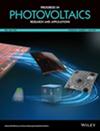A Spatially Resolved Evaluation of Accelerated Environmental Aging on Emerging Polypropylene-Based Photovoltaic Backsheets Using Raman Spectroscopy
Abstract
Accelerated aging was used to assess environmental degradation in emerging co-extruded polypropylene (PP)-based backsheets under three different environmental conditions (65°C/20% relative humidity (RH), 75°C/20% RH, and 75°C/50% RH). Although differential scanning calorimetry did not measure crystallinity changes with exposure, spatially resolved Raman spectroscopy identified crystallinity increases in the core layer of aged samples, indicating a heterogeneous postcrystallization process. The Raman results were in agreement with synchrotron-based microfocused wide-angle X-ray scattering measurements. Cross-sectional nanoindentation was used to correlate localized crystallinity shifts with changes in Young's modulus. A similar trend was found where increased modulus was measured in the core layer, supporting the relationship between modulus and crystallinity. Finally, dielectric characterization was used to assess the impact of these material property changes on performance. While changes in the backsheet material properties and dielectric performance were observed with accelerated aging, these shifts generally equilibrated with time, indicating overall stability in response to environmental stressors. Additionally, the identified heterogeneous material property changes indicate that spatially resolved crystallinity measurements may be a valuable early failure indicator to be used in the assessment of PV backsheet long-term durability.


 求助内容:
求助内容: 应助结果提醒方式:
应助结果提醒方式:


